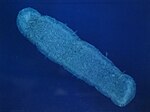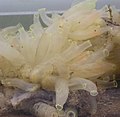A zooid or zoöid /ˈzoʊ.ɔɪd/ is a single animal that is part of a colonial animal. This lifestyle has been adopted by animals from separate unrelated taxa...
4 KB (462 words) - 20:31, 31 October 2021
Siphonophorae (section Zooids)
organism composed of medusoid and polypoid zooids that are morphologically and functionally specialized. Zooids are multicellular units that develop from...
32 KB (3,546 words) - 20:14, 23 May 2024
Bryozoa (section Types of zooid)
some colonies can creep very slowly by using spiny defensive zooids as legs. Each zooid consists of a "cystid", which provides the body wall and produces...
135 KB (13,109 words) - 15:51, 15 August 2024
ZOOiD BBS ("the zoo of ids," or alternatively referencing zooid) was a Toronto area Bulletin board system in 1986 - 1993 that served a creative community...
929 bytes (113 words) - 21:46, 13 March 2023
sea". Each zooid is a few millimetres in size, but is embedded in a common gelatinous tunic that joins all of the individuals. Each zooid opens both to...
10 KB (991 words) - 21:04, 10 August 2024
made up of many smaller units called zooids. Although they are morphologically quite different, all of the zooids in a single specimen are genetically...
50 KB (5,023 words) - 00:53, 9 August 2024
Graptolite (section Zooids)
graptolites and Rhabdopleura share a colony structure of interconnected zooids housed in organic tubes (theca) which have a basic structure of stacked...
35 KB (3,463 words) - 19:07, 1 July 2024
Entoprocta (section Zooids)
are colonial, and their members are known as "zooids", since they are not fully independent animals. Zooids are typically 1 millimetre (0.039 in) long but...
30 KB (3,235 words) - 13:11, 9 July 2024
marine bryozoans, phylactolaemate colonies consist of only one type of zooid, the feeding forms known as autozooids. These are supported by an unmineralized...
6 KB (544 words) - 15:21, 25 March 2024
others replicate by budding and become colonies, each unit being known as a zooid. They are marine filter feeders with a water-filled, sac-like body structure...
63 KB (7,336 words) - 09:10, 5 August 2024
currents. It lives in colonies of one to four transparent individuals or zooids measuring up to 2 centimetres (0.79 in) each. Individuals in a colony are...
12 KB (1,371 words) - 18:22, 13 August 2024
reproductive structures known as gonozooids. In some species, further specialised zooids are formed. Dorit, R. L.; Walker, W. F.; Barnes, R. D. (1991). Zoology....
2 KB (197 words) - 14:48, 16 August 2024
siphonophore, a jelly-like marine animal, is composed of organism-like zooids, but the whole structure looks and functions much like an animal such as...
25 KB (2,322 words) - 04:23, 18 August 2024
Membranipora membranacea colonies consist of individual organisms called zooids, each with a chitinous exoskeleton which is secreted by the epidermis. This...
9 KB (1,031 words) - 20:24, 15 October 2023
include both sexual and asexual zooids in three sequential "generations". The nurse produces buds (which grow into new zooids) in its ventral stalk, but the...
7 KB (917 words) - 13:08, 3 July 2024
be 60 centimeters (2 feet) in diameter. The individual organisms termed zooids feed using a lophophore in which cilia on the tentacles capture microscopic...
2 KB (168 words) - 22:13, 15 July 2024
bryozoans encompasses most of the organs and tissues of each individual zooid. This includes the tentacles, tentacle sheath, U-shaped digestive tract...
1,016 bytes (106 words) - 01:08, 3 February 2024
colony of tiny biological components called zooids, each having evolved with a specific function. Zooids cannot survive on their own, relying on symbiosis...
8 KB (768 words) - 18:59, 28 March 2024
Communication by light emission between the zooids enables coordination of colony effort, for example in swimming where each zooid provides part of the propulsive...
75 KB (8,096 words) - 09:16, 17 August 2024
twenty-piece Society Situation Dance Band, Very Very Circus, X-75, and Zooid. He was awarded the 2016 Pulitzer Prize for Music for his album In for a...
18 KB (1,740 words) - 04:01, 31 July 2024
for a Pound is an album composed by Henry Threadgill for his jazz quintet Zooid, featuring Jose Davila, Liberty Ellman, Christopher Hoffman, and Elliot...
7 KB (634 words) - 02:27, 14 June 2024
within a multicellular colonial organism may be called ramets, modules, or zooids. Structural and functional variation (polymorphism), when present, designates...
17 KB (1,971 words) - 21:40, 6 August 2024
ascidians that consist of many small individuals (each individual is called a zooid) forming large colonies. Sea squirts feed by taking in water through a tube...
41 KB (4,900 words) - 20:14, 20 August 2024
suborder under class Cheilostomida defined by the lack of an ascus in each zooid. It is no longer an accepted taxonomic grouping as it is considered a polyphyletic...
907 bytes (66 words) - 18:57, 16 December 2023
located along one margin of the zooid-bearing lobe by which they are attached to a hard substrate. The pharynx of each zooid (colony member) has 13-17 rows...
10 KB (1,316 words) - 04:57, 20 December 2023
water-filled sac of frontal membrane opening (ascopore) at or near the zooid orifice. It functions as a hydrostatic system by allowing water into the...
1 KB (156 words) - 11:24, 28 February 2021
night. They can occur in very dense swarms, as solitary zooids or as colonies. Solitary zooids usually measure 22 to 52 mm (0.87 to 2.05 in) in length...
3 KB (186 words) - 02:21, 24 May 2024
cheilostome bryozoans is a modified, non-feeding zooid. The operculum, which normally closes the orifice when the zooids tentacles are retracted, has been modified...
2 KB (221 words) - 16:37, 16 April 2024
primary type is the sessile trophont stalked zooid. When environmental conditions deteriorate the stalked zooid excises its stalk and transforms into Vorticella's...
5 KB (499 words) - 14:57, 14 April 2024






















